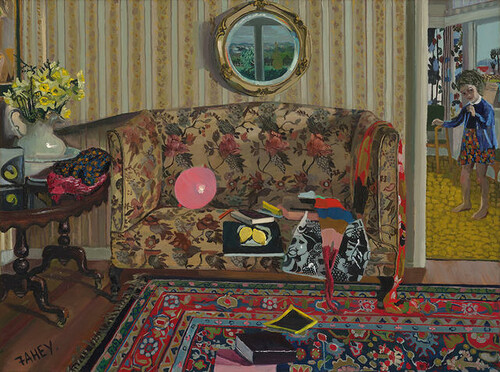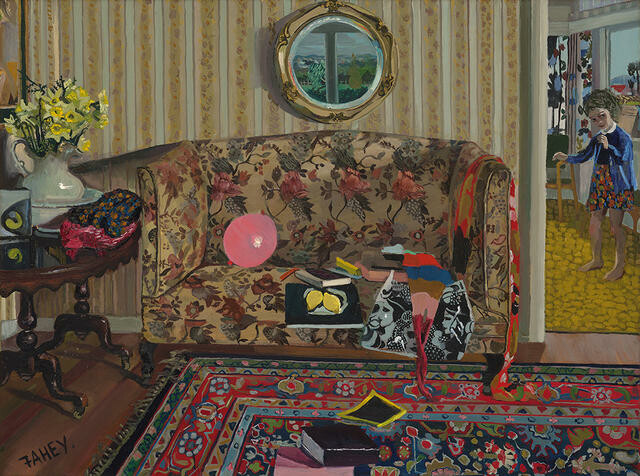B.
Portobello Settee by Jacqueline Fahey
Collection
This article first appeared in The Press on 19 January 2018 as 'A settee with hidden depths'.
A plump pink balloon rests lightly on the elegant couch that gives The Portobello Settee its name. Inflated almost past bursting point, its fullness is echoed by the room around it, in which busy floral patterns compete with striped wallpaper while books and scarves slide in an unruly cascade to the floor. Through the doorway, we catch an almost incidental glimpse of a young girl. Caught mid-movement, hands outstretched, she returns our gaze with an expression that is both knowing and slightly unsettling.
Such intensity, dishevelment and ambiguity are characteristic aspects of Jacqueline Fahey’s practice, and never more so than in the acutely observed domestic interiors she painted throughout the 1970s. After marrying Fraser McDonald, who would become a noted psychiatrist, Fahey spent years raising their children in houses on hospital grounds around New Zealand. She soon realised that for her art practice to survive, it would have to become a non-negotiable part of family life: “I decided that instead of getting away from it all, I would embrace domesticity; transform it, interpret it. Who better than someone immersed in it?”
Working from a large trolley, Fahey wheeled her paintings around the house, following the action as it unfolded before her. With three daughters, who grew from charismatic toddlers into spirited teenagers, she had no shortage of material. From chaotic birthday parties and ferocious arguments to the desolate grief she shared with her mother after the death of her father, Fahey’s paintings captured private life with fierce authenticity, offering unprecedented insights into its conflicts, pleasures and frustrations. More than forty years later these unflinching appraisals, often leavened with wry humour, remain relevant and compelling viewing.
In 1974, Islands magazine invited 19 artists to write about one of their own works. Fahey chose The Portobello Settee, describing the process of painting it as almost effortless: “It just went like a bird. I felt certain of my vision, certain I could endow my humble objects with mana because for a while they were totally beautiful to me.” Notwithstanding that ease of execution, Fahey’s composition is far from straight-forward – this apparently ‘ordinary’ interior view combines multiple intersecting perspectives that compete for our attention. The light reflected in the central pink balloon comes from a window behind the artist, a window we see only in reflection, caught in a mirror above the settee. It’s a deliberately complex, ‘more is more’ approach that underscores Fahey’s interest in messy open-endedness rather than neat reduction. “All of the viewpoints are true and none of them are true” she once explained. “What you see depends on where you are looking from.”
The Portobello Settee is one of 25 paintings on display until 11 March as part of ‘Jacqueline Fahey: Say Something!’ at Christchurch Art Gallery Te Puna o Waiwhetū.


